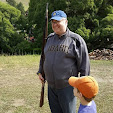Two readers, Bill and James, recently emailed with questions about my painting method and the color combinations I use. Hopefully this post will help!
First, I usually prime black. Any flat enamel paint will work. I buy my cans of spray paint at Walmart for $.99 each. The paint comes out in a this spray, so I usually apply two coats. It dries extremely flat.
I block paint the figures in my shade colors. They start off very dark, but I will add highlights to brighten them and make them pop.
Here are the colors I used for the block painting.
Americana "Evergreen" for tunics and cockades; Delta's "Cayenne" for flesh; Delta's "Brown Iron Oxide" for facings, chin scales, brass shako and cartridge box badges, and scabbards; Delta's "Autumn Brown" for musket stocks; Delta's "Mudstone" for shako cords, musket slings, breeches, and belts; Delta's "Dark Chocolate" for blanket rolls; Delta's "Oyster White" for cockades; Vallejo's "Oily Steel" for canteens, musket lock, barrel, and bayonet; Vallejo's "Old Gold" for buttons and scabbard ends.
Craft paints do not have great coverage, but they work well over these shade colors. I paint the highlights and leave recesses in the shade color. This accentuates the figure's three-dimensionality and adds depth to the eye.
Here are the colors I used for the highlight painting.
Delta's "Oyster White" for shako cords, musket slings, belts, and breeches; Americana's "Forest Green" for tunics; Delta's "Toffee Brown" for scabbards; a mix of Delta's "Territorial Tan" and "Dark Chocolate" for blanket rolls; Delta's "Medium Flesh" for faces and hands; Vallejo's "Old Gold" for sword hilts, chin scales, and brass badges; Vallejo's "Flat Red" for facings.
Once the figures are all based, I will paint the shoulder straps in appropriate colors.
Hopefully this short guide is of some help! I know this method enables me to paint a large number of figures relatively quickly while keeping a high standard.
What Have I Done?
10 hours ago



















